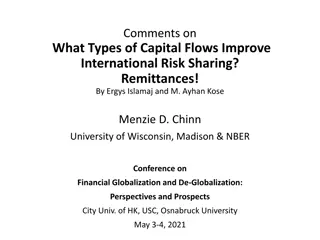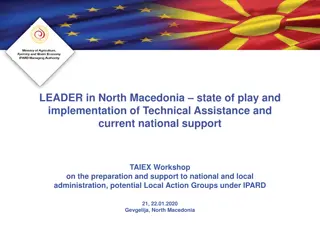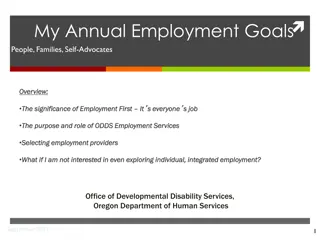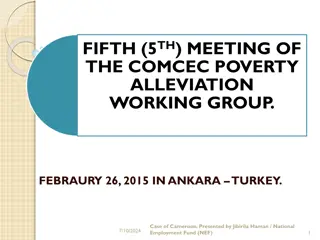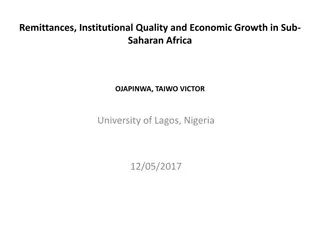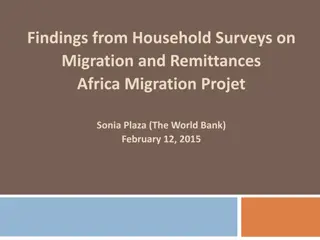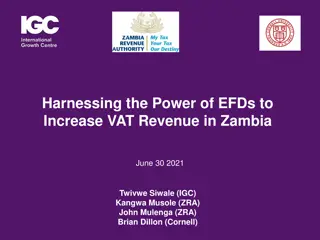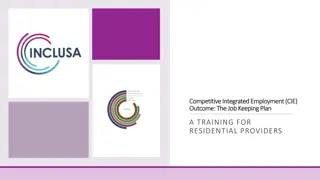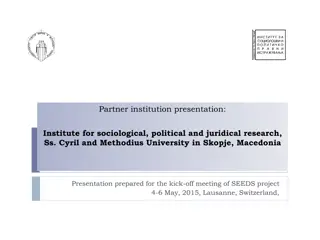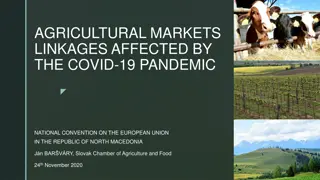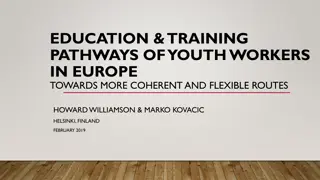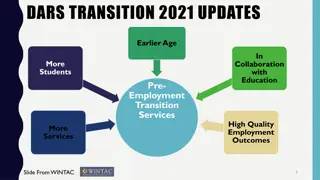Youth Employment and Remittances in Macedonia: A Study of Opportunities and Challenges
Investigating the impact of remittances on youth employment in Macedonia, this research explores the motivations, challenges, and potential solutions in light of high unemployment rates and significant remittance inflows. Issues such as job creation, credit constraints, and consumption patterns are addressed, with a focus on understanding how remittances influence youth employment dynamics in the country.
Download Presentation

Please find below an Image/Link to download the presentation.
The content on the website is provided AS IS for your information and personal use only. It may not be sold, licensed, or shared on other websites without obtaining consent from the author. Download presentation by click this link. If you encounter any issues during the download, it is possible that the publisher has removed the file from their server.
E N D
Presentation Transcript
Youth self-employment in households receiving remittances in Macedonia Marjan Petreski University American College - Skopje 2014 PEP Annual Conference Santa Cruz de la Sierra, Bolivia May 5-6, 2014
Contents Motivation Research objective Related literature Methodology and data Research results/key findings Conclusions and policy recommendations
Context - motivations Some facts for Macedonian labor market Very high and persistent unemployment rate 28.6% in Q4-2013 Youth unemployment is 52%, implying one of two young persons cannot find a job Active labor market policies in place (for youth) Subsidized employment for youth Grants and loans for self-employment Internships and volunteering However, results largely absent
Context motivations (2) Hence Low job creation for youth, along with: Uncertainty for investment Tightened credit conditions Lack of venture finance Malfunctioning labor market Restrains their entrepreneurial spirit and prevents risking new venture
Context motivations (3) On the other hand Macedonia is estimated to be a recipient of large amount of international remittances About 20% of GDP Out of which about half is estimated to be cash transfers still larger than FDI Remained large and growing, even over the crisis, due to diaspora being located in countries which were not severely hit by the crisis However, large parts are spent for consumption, including consuming durable goods (cars, houses, flats etc.) Rarely invested in longer-term ventures
Section title Research project and objectives The objective of the research is: to investigate how the employment status of youth in Macedonia varies owing to remittances inflow in the country
Section title Related literature Remittances and employment Neoclassical model of labour-leisure choice (Killingsworth, 1983): remittances may alleviate budget constraints, raise reservation wages and reduce the employment likelihood Empirical results mixed, but prevalently suggesting that remittances reduce employment probability Remittances and small businesses Remittances improve the access to capital funds, which alleviates the credit constrain for starting a business (Lucas and Stark, 1985; Ruiz and Vargas-Silva, 2009). This effect might be amplified in countries with underdeveloped capital and insurance markets, including micro-credits (Kilic et al. 2007). Moreover, having a migrant can be viewed as a tool for diversifying the risk while substituting for formal insurance. Dermendzhieva (2011) and Funkhouser (1992): remittances provide initial capital for starting a business in Armenia and Nicaragua, respectively. Taylor and Mora (2006) and Woodruff and Zenteno (2001): the likelihood that a Mexican household invests is positively associated with having a migrant. Woodruff and Zenteno (2001) find that remittances are responsible for almost one fifth of the capital invested in microenterprises throughout urban Mexico.
Section title Related literature (2) Remittances and youth Literature is scarce To date, the study of Braga (2009) for Albania is the sole study which examines the link between remittances and labour market behaviour of young people (aged 15-24) in remittance receiving households. Remittances reduce the probability of young people being inactive which might point that young people more wisely spend remittances and/or are less risk-averse. The effect is stronger for females. The finding that young people spend remittances cleverer might be related to the lack of alternative channels to finance business start-ups that they face: microcredit, venture capital, CCTs
Section title Data DotM survey 2009 1211 households Slightly older, but focused both on individual and household characteristics (more than 160 questions) N.B. No remittances data in standard surveys (HBS, SILC)
Section title Survey statistics Table 1. Some statistics from the survey employed Albanian # of HHs headed Female Skopje Urban Rural Poor Self 1211 42.6% 25.7% 26.9% 26.1% 50.5% 23.5% 15.9% Source: DoTM Survey (2008).
Section title Survey statistics (2) Table 1. Households with absent migrant reported absent migrant 165 177 342 Remittances receiving Percentage of hh with 96.8% 97.9% 97.4% % of hh with migrants 43.6% 45.2% 44.4% close-family migrants receiving households not sending money % of remittances' 13.4% 18.8% 15.7% households who Total number of The number of households 695 516 1211 households 93 97 190 Male-headed Female-headed Total Source: DoTM Survey (2008).
Section title Survey statistics (3) Table 1. Self-employment rates for individuals in remittance-receiving and non- receiving households All Remittances receivers Non- remittances receivers 10.8% All Male Female Macedonian Albanian Capital Urban (other than capital) Rural Young Non-young Source: DoTM Survey (2008). 10.8% 11.6% 16.5% 5.4% 16.0% 8.9% 16.5% 5.3% 10.5% 11.5% 8.0% 19.0% 10.6% 11.2% 10.6% 9.2% 13.8% 8.5% 11.5% 23.1% 4.3% 19.6% 13.0% 11.3% 10.4% 9.4% 13.5% 8.4% 11.5%
Section title Survey statistics (4) Table 1. Percentage of respondents thinking that money sent back may be used for starting up a business All Remittance receivers Non- remittance receivers 6.41 5.95 6.58 All Young Non-young Source: DoTM Survey (2008). 6.55 6.16 6.7 10.79 14.29 9.91
Section title Methodology Dummy for self-employed = F(education, ethnicity, gender, geographical area, household size, distance from main employment centers, dependency ratio, access to finance and the like), adding A dummy for young (15-29, national definition) or not An indicator of whether the household is a recipient of remittances Interaction of the variables to estimate if remittances increase the probability for youth to establish own business Regressions conducted for gender, ethnicity and urban-rural. Remittances are endogenous E.g. Failure the establish own business due to credit constraints, regulatory burden and so on; Roodman s (2011) conditional mixed-process (CMP) estimator Instruments Other family member migrated before Non-economic motive to migrate
Section title Key findings (1) Results suggest that: if a household receives remittances, the probability of a member being self-employed declines in the magnitude of between 47% and 52%, than compared to non-receiving households. However, when it comes to young members in the receiving households, the probability to establish their own business is larger by 51 to 57% than their non-young counterparts in the non-receiving households. Hence, while the literature likely documented the parasitism effect of remittances, it may overlook the entrepreneurial spirit of the youth, who are more likely to recognize a source of financing in remittances, to channel into longer-term productive usage.
Section title Key findings (2) Differentialanalysis Albanian youth proclivity is on average 3.1% lower that of Macedonians. The probability of Albanian youth s in receiving households to invest is about 12% lower than for Macedonian youth. Lower average level of education of Albanian youth; Ohrid Framework Agreement (2001): entitles Albanian ethnicity for quota employment into the public institutions and the government. Male youth are more inclined to establish own business, suggesting that women s entrepreneurial spirit should be relatively more supported in the country (vs males ). However, when it comes to households receiving remittances, we were unable to obtain separate estimate for both genders. Rural youth were found to show less entrepreneurial spirit than urban youth, while youth living in the capital are even more enclined to invest that other urban outh Also unable to obtain separate estimates for households receiving remittances
Section title Key findings (3) Robustness analysis Results remain largely robust to the following changes/additions: Using the widespread definition of youth (15-24 years of age), instead of the national definition (15-29); Or adding the following opinions, as to whether: the government should be responsible for securing better jobs; the government secures favourable business climate; remittances cause laziness among receivers.
Section title Policy implications Findings have a major policy implication as: remittances were found to have a large potential to steer the entrepreneurial spirit of youth in Macedonia given that no systematic remittances policy currently exists despite the government interest in the topic The government should therefore, and soon, start devising a strategy for channelling remitted money into more productive use, especially converting those funds into jobs for youth.
Section title Conclusions Results robustly suggest that youth in households receiving remittances have considerably larger probability to establish own business, ranging between 51% and 57% than compared to the non- young non-receiving counterparts. The study also documented the widespread result in the literature that remittances, in general, create parasitism and reduce the probability of establishing own business, which is in line with the risk- aversion which likely increases with age. However, this result does not apply for youth a finding largely absent in the referent literature. We documented that ethnic Albanian youth in receiving households have lower entrepreneurial inclination; while remittance-receiving youth have quite higher probability to establish own business in the capital than compared to the other cities.
Section title Policy recommendations Some lines of though : Exclusion of paying social contributions for young receiving remittances who start a business; Financial support from the budget in the amount of 30% of the received remittances in the course of a year if these are invested in starting of new business; Direct subsidies in the second year of operation in the amount of 50% of the remittances received if the self-generated business is in the area of high technologies (for instance ICT); Full exemption of paying tariff on capital-goods imports, like machines, equipment, technology, fertilizers etc; Subsidizing the costs of interest for obtaining loans for expansion after the third year of operation; Increasing agricultural subsidies for agricultural start-ups by youth receiving remittances in rural areas; Special social protection and child care for spouses and children of young having established a business from remittances. Subsidizing the costs of training of each member of the receiving household whereby a business has been created by a young member; Subsidizing the costs for branding of agricultural products of agricultural firms created and run by youth receiving remittances; Government-supported promotion of businesses set and run by female youth receiving remittances.
Thank you! This research work was carried out by : With technical and financial support from : Under the PEP research and capacity building initiative for Policy Analysis on Growth and Employment (PAGE) The PEP-PAGE initiative is supported by the following donors:


